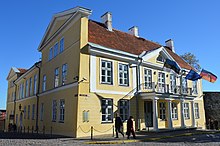German Embassy Tallinn
|
|||
|---|---|---|---|
| State level | bilateral | ||
| Position of the authority | Embassy | ||
| Supervisory authority (s) | Ministry of Foreign Affairs | ||
| Consist | since 2.9.1991 | ||
| Headquarters |
|
||
| ambassador | Christiane Hohmann | ||
| Website | tallinn.diplo.de | ||
The German embassy in Tallinn is the headquarters of the diplomatic mission of Germany in Estonia . The embassy office is located at Königstalerstraße ( Estonian Toom-Kuninga ) 11, the residence at Schlossplatz (Lossi plats) 7 in the Estonian capital Tallinn ( German Reval ).
Christiane Hohmann has been the German ambassador to Estonia since July 2019 .
history
The history of diplomatic relations between Germany and Estonia began with the de facto recognition of the Estonian government formed by Konstantin Päts on November 19, 1918 by August Winnig (SPD), Plenipotentiary of the German Reich for the Baltic States . This was followed by a telegram from the German People's Government to the Estonian government on November 24, 1918 , in which Reich Commissioner Winnig was appointed envoy on an extraordinary mission to the Latvian and Estonian government. Winnig, who was also Reich Commissioner for East and West Prussia , had his official seat in Riga , and from January 1919 in Königsberg .
Winnig had his seat in Riga for a short time, then from January 1919 in Königsberg and as the German Reich Commissioner for East and West Prussia kept the title "The German envoy to the Latvian and Estonian government" until the summer of 1919 then Ago von Maltzan as the "agent of the Foreign Office for Estonia and Latvia". His official seat was also Königsberg. In Reval itself, from December 11, 1918 to November 1919, Captain Max Vogl was the representative of the German envoy to the Estonian government . His successor was Fritz Henkel . On December 25, 1919, he was appointed vice consul to head the embassy business and acted as the German chargé d'affaires for Estonia. After Germany had also recognized Estonia de jure, Otto von Hentig took over the official business and handed over his credentials on July 9, 1921 .
From the beginning, the seat of the representation was located on the property at Königstaler Strasse 11, which is still in use today. The building erected in 1890 housed both the envoy's offices and apartment.
In 1923 the representation was converted into a legation . The embassy was rather small. In 1924, during the term of office of Bruno Wedding , there was only one chancellor as an official of the higher service in addition to the envoy. In addition, a clerk, a registrar, a caretaker as well as messengers and porters were active. After several other envoys, the last envoy before the Second World War was Hans Frohwein . He handed over his credentials on March 9, 1936 and remained in office until the legation was closed. The legation was closed in August 1940 after Estonia was occupied by the Soviet Union as part of the implementation of the Hitler-Stalin Pact .
In the summer of 1942, the legation building was only preserved as a burned-out ruin.
Estonia regained its independence on August 20, 1991. During a joint visit by the foreign ministers of the Baltic States of Estonia, Latvia and Lithuania to Bonn on August 28, 1991, it was decided to resume diplomatic relations. Henning von Wistinghausen was Germany's first ambassador to hand over his credentials on September 2, 1991 in Reval. On July 1, 1993, following an order from the Estonian government, the original property of the embassy of the German Empire in Königstalerstraße was handed over to the Federal Republic of Germany and is used as the office of the German embassy.
The residence at Schlossplatz 7 was rented by the Federal Republic of Germany from the Estonian state and is located on Toompea Reval in the immediate vicinity of the Estonian parliament Riigikogu and the Alexander Nevsky Cathedral . The inauguration as an embassy residence took place on May 25, 1994 by the German Foreign Minister Klaus Kinkel in the presence of the Estonian President Lennart Meri .
The office of the embassy was established at Königstalerstraße 11. The Scandinavian-style building was built according to plans by the architects Kersten + Martinhoff from Braunschweig and Künnapu & Padrik from Reval. It has a wooden facade, large glass surfaces and an atrium. The inauguration took place on September 28, 1998.
History of the embassy residence at Schlossplatz 7
The current residence building was owned by German-Baltic noble families in the 18th and 19th centuries. Helmuth von Lilienfeld sold the building to the Estonian state in 1921. It was considered one of the most beautifully furnished houses in Reval. The Estonian Prime Minister Konstantin Päts moved into the building on December 20, 1921 as his residence. In 1934 the house was handed over to the Estonian Ministry of Justice. During the German occupation of Estonia from 1941 to 1944, the house was the seat of the German civil administration for Reval, the commissioner for Reval-Stadt. During the period of the renewed Soviet occupation of Estonia, the Ministry of Health was set up in the house in 1950/51. After a significant deterioration in the fabric of the building, renovation began in the late 1980s. The restoration was completed by the Federal Republic of Germany after the building was rented.
Today the ambassador's living and representative rooms are located in the house.
German heads of mission in the Republic of Estonia
The German heads of mission in Estonia since 1919 emerge from the list of German ambassadors in Estonia .
Web links
Coordinates: 59 ° 26 ′ 9.2 ″ N , 24 ° 44 ′ 23.9 ″ E


